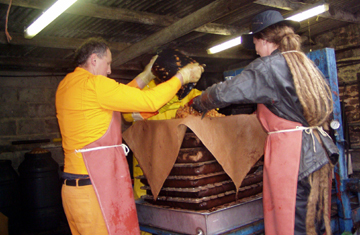
Pear bonding Making perry is an unhurried and complex process
The U.K. may have long struggled to be taken seriously as a wine producer but there is a distilled, fruit-based beverage at which it excels. Perry (or pirie, as it was once called, a derivation from pirige, the Anglo-Saxon word for pear) is a delicate drink that had its heyday between the late 17th and early 19th centuries. Because the perry pears (as opposed to table pears) used to produce it are difficult to grow, with orchards taking at least 25 years to yield fruit, production of perry began to decline with the introduction of mechanized farming methods from the late 19th century. But these days, the beverage is enjoying a dramatic revival, thanks in part to a renewed interest in cider, its close cousin, and a desire by some farmers to return to traditional styles of cultivation.
While a little perry is made in Wales, the English counties of Herefordshire, Gloucestershire and Worcestershire are its heartland. Over the past 10 years, the dedication of several artisanal producers in these areas has put the drink back on the map. One such perrymaker, Tom Oliver, theolivers.org.uk, has been commercially producing perry and cider at Ocle Pychard in Herefordshire for just over a decade. Oliver, who also happens to be the road manager of the Scottish band the Proclaimers, makes nearly 38,000 L a year, a tenth of which he supplies to the U.S. via a beer importer in Massachusetts. "Perry is completely different to any other drink," he says. "It's more demanding than cider and, though less alcoholic than wine, has the same nuances of nose and flavor — notably citrus and hedgerow fruits." In fact, many producers argue that perry should be treated as an equivalent to wine because it goes very well with food.
Although relatively easy to make in theory, perry is a hard taskmaster, not least because pear juice is more difficult to ferment than the apple juice used to make cider. The skill, according to James Marsden of Gregg's Pit Cider & Perry, greggs-pit.co.uk, is judging and balancing ripeness, maceration, pressing, sugar levels and the time that perry is left to ferment in the barrels (usually between three and six months). Some producers add another element to the fermenting process by maturing the perry in old whiskey, brandy or rum casks. "We let the fruit do the talking, but anything that adds to the flavor helps differentiate it as some perrys are very delicate," says Oliver.
This kind of handmade quality only adds to perry's appeal and places it a world away from so-called "pear cider," a mass-produced drink from big commercial brewers. "Pear cider is an oxymoron [since] cider is made with apples," says Marsden, who sees a link between the perry renaissance and the U.K. public's growing appetite for seasonal and authentic produce of known provenance.
There are more than 100 kinds of perry-pear tree (many are rare, with just a handful of trees confined to individual orchards). Colorfully named varietals such as Mumblehead and Merrylegs are used to make either single-variety or blended perry. Bottlings range from sweet to dry, and can be still or slightly sparkling. Mike Johnson, who runs Ross-on-Wye Cider & Perry, rosscider.com, and produces around 5,600 L a year, believes that the 2009 vintage could be a particularly good one because of favorable weather conditions during the growing and harvesting period. But don't just take his word for it. It's time you get acquainted with this luscious example of English exotica for yourself.
